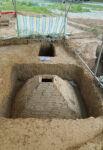 Archaeologists have discovered brick chamber tombs decorated with rich murals dating to the Ming Dynasty (1368-1644) in the city of Changzhi, Shanxi Province, northern China. Three tombs believed to be family tombs from the early Ming Dynasty were found. Two of the them are intact. The roof of the third, a rectangular brick tomb with a vaulted ceiling, has collapsed, damaging the walls and contents, but the remains of a mural are still visible.
Archaeologists have discovered brick chamber tombs decorated with rich murals dating to the Ming Dynasty (1368-1644) in the city of Changzhi, Shanxi Province, northern China. Three tombs believed to be family tombs from the early Ming Dynasty were found. Two of the them are intact. The roof of the third, a rectangular brick tomb with a vaulted ceiling, has collapsed, damaging the walls and contents, but the remains of a mural are still visible.
The Shanxi Provincial Institute of Archaeology began excavating the site last year in advance of road construction. They encountered a tomb on the southeast, one on the north and one of the southwest of the site. The rectangular tomb with the collapsed ceiling was the southeastern one. The other two are brick with pyramidal roofs. They are in good condition, with the murals — very similar in style and subject — still in vivid color.
 The murals depict religious motifs and scenes from daily life, reflecting the idea that people would live much the same lives after death as they had before. The central burial chambers are painted with florals and faux architectural features including wooden doors, lattice windows, pillars, eaves and rafters that mimic the style of a residence from the period.
The murals depict religious motifs and scenes from daily life, reflecting the idea that people would live much the same lives after death as they had before. The central burial chambers are painted with florals and faux architectural features including wooden doors, lattice windows, pillars, eaves and rafters that mimic the style of a residence from the period.
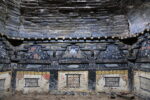 The murals also include celestial imagery. There’s a star on the roof. On the eastern wall is a red disc with a bird in the center that represents the sun and the mythological crow or phoenix associated with the sun. On the opposite wall is the moon, a white disc on which the mythological Jade Rabbit stands under a tree, constantly pounding the elixir of life.
The murals also include celestial imagery. There’s a star on the roof. On the eastern wall is a red disc with a bird in the center that represents the sun and the mythological crow or phoenix associated with the sun. On the opposite wall is the moon, a white disc on which the mythological Jade Rabbit stands under a tree, constantly pounding the elixir of life.
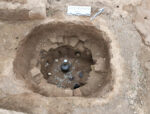 A brick octagonal structure discovered in the excavation appears to have had some ritual function connected to the tombs. It is five feet in diameter and has six niches on its interior walls where statuettes and other objects were placed. The excavation unearthed 18 objects including large ceramics, bronze coins and bronze mirrors.
A brick octagonal structure discovered in the excavation appears to have had some ritual function connected to the tombs. It is five feet in diameter and has six niches on its interior walls where statuettes and other objects were placed. The excavation unearthed 18 objects including large ceramics, bronze coins and bronze mirrors.
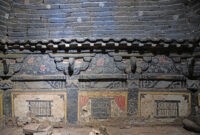
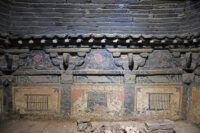
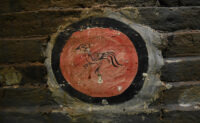
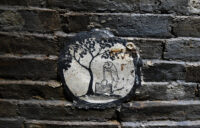
…any word about the occupants?
In addition to the missing content and information on the tomb owners/ inhabitants, I find the size(s) hard to estimate.
On some of the pictures, the vaults look rather small, while on others, the impression is that of a rather huge one.
:hattip:
PS: In Mycene, i.e. nearby, I saw the gargantuan –but emptied– 13th century BC vaulted tomb of which Pausanias said, it was the “Treasury of Atreus” with an interior height of 13.5m (not to be confused with the shaft graves within Mycene, where the famous Bronze Age gold mask was found that had been wrongly attributed to king “Agamemnon”):
upload.wikimedia.org/wikipedia/commons/3/36/20211112_argolida092.jpg
upload.wikimedia.org/wikipedia/commons/7/75/20211112_argolida098.jpg
upload.wikimedia.org/wikipedia/commons/f/fc/20211112_argolida094.jpg
—————–
Pausanias, the geographer from the second century AD, in [Description of Greece/ Ἑλλάδος Περιήγησις, 2.16.6/7]:
“In the ruins of Mycenae is a fountain called Persea; there are also underground chambers of Atreus and his children, in which were stored their treasures. There is the grave of Atreus, along with the graves of such as returned with Agamemnon from Troy, murdered by Aegisthus after he had given them a banquet. As for the tomb of Cassandra, it is claimed by the Lacedaemonians who dwell around Amyclae. Agamemnon has his tomb, and so has Eurymedon the charioteer, while another is shared by Teledamus and Pelops, twin sons, they say, of Cassandra, whom while yet babies Aegisthus slew after their parents. Electra has her tomb, for Orestes married her to Pylades. Hellanicus adds that the children of Pylades by Electra were Medon and Strophius. Clytemnestra and Aegisthus were buried at some little distance from the wall. They were thought unworthy of a place within it, where lay Agamemnon himself and those who were murdered with him.”
—————–
I find it fascination how the deceased back in the day were treated with more joy than sorrow. This mural provides an insight that the dead shall be celebrated.